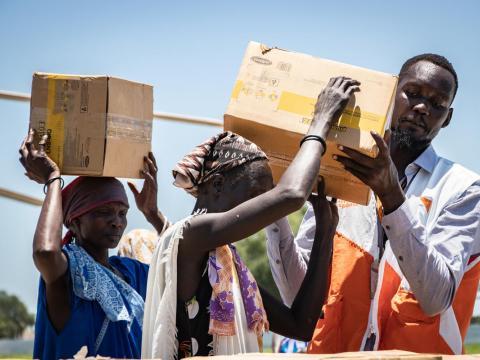World Vision response to WFP food cuts in South Sudan

Monday, 13th September, 2021 - World Vision is saddened to today hear that the World Food Programme has been left with no option but to suspend food assistance for 106,000 displaced people in parts of South Sudan due to sharply increasing humanitarian need with funding to meet those needs not keeping apace.
South Sudan is one of 6 countries that has been identified by the international community as having populations living in famine-like conditions (IPC 5). In June 2021, the leaders of the G7 endorsed their Global Compact on Famine Prevention and Humanitarian Crises, pledging US$8.5 billion to meet the most urgent needs in the most at risk countries. Unfortunately, those commitments have been slow to materialise as resources in the hands of those that desperately need them. This means WFP has had to make a very difficult decision today to cut the rations of one very high needs group of people to meet the even more urgent needs of another population in even more difficult circumstances.
As World Food Programme’s main food distribution partner is South Sudan almost all people impacted by this are World Vision beneficiaries, and 67% of the people the NGO serves in South Sudan are children.
People living in desperate situations, who rely on humanitarian aid to survive, will now receive half of the amount of food a person needs to function. This means that an active adult male will consume fewer calories than recommended for a moderately active 5-year-old child in Canada, the UK and the United States.
World Vision South Sudan National Director Mesfin Loha today said "South Sudan remains in a very dire humanitarian situation. It is currently experiencing one of the severest levels of food insecurity. Over 60% of its 12 million people are in need of emergency food assistance. The recent WFP announcement on the food assistance cuts will be a devastating blow to the already very fragile situation.
“Our hearts break on the suffering of the country’s most vulnerable population, the children, women and the elderly. The donor community and the rest of the world must rise to the challenge of averting this impending catastrophe.”
ENDS.
Notes to editor:
WFP’s announcement comes at a time when more than 41 million people around the world are experiencing Emergency (IPC 4) levels of hunger, a 50% increase in one year. This is due to a deadly mix of conflict, climate change and the economic impacts of COVID-19 are sharply increasing humanitarian need across the globe with the necessary financial resources are not keep apace. Of most urgent concern are the 584,000 people already living in Catastrophe/Famine (IPC 5).
The Integrated Food Security Phase Classification (IPC) system is 1) a standardized scale of food insecurity; and 2) a process for building interagency technical consensus on the state of food insecurity in a specific country at a given moment and are meant to provide technically rigorous data to support decision-making. The 5 ‘phases’ of food insecurity are: Phase 1 (None/Minimal), Phase 2 (Stressed), Phase 3 (Crises), Phase 4 (Emergency) and Phase 5 (Catastrophe/Famine)..
For more information please contact:
Cecil Laguardia, Senior Manager for Advocacy and Communications
Email: cecil_laguardia@wvi.org I Phone: +211922287768 I Skype: cecil_laguardia
World Vision is a Christian humanitarian organisation dedicated to working with children, families and their communities to reach their full potential by tackling the root causes of poverty and injustice. World Vision serves all people, regardless of religion, race, ethnicity or gender. For more information, please visit www.wvi.org or follow us on Twitter @WorldVision